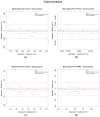Measuring Surface Electromyography with Textile Electrodes in a Smart Leg Sleeve
- PMID: 38732868
- PMCID: PMC11086330
- DOI: 10.3390/s24092763
Measuring Surface Electromyography with Textile Electrodes in a Smart Leg Sleeve
Abstract
This paper presents the design, development, and validation of a novel e-textile leg sleeve for non-invasive Surface Electromyography (sEMG) monitoring. This wearable device incorporates e-textile sensors for sEMG signal acquisition from the lower limb muscles, specifically the anterior tibialis and lateral gastrocnemius. Validation was conducted by performing a comparative study with eleven healthy volunteers to evaluate the performance of the e-textile sleeve in acquiring sEMG signals compared to traditional Ag/AgCl electrodes. The results demonstrated strong agreement between the e-textile and conventional methods in measuring descriptive metrics of the signals, including area, power, mean, and root mean square. The paired data t-test did not reveal any statistically significant differences, and the Bland-Altman analysis indicated negligible bias between the measures recorded using the two methods. In addition, this study evaluated the wearability and comfort of the e-textile sleeve using the Comfort Rating Scale (CRS). Overall, the scores confirmed that the proposed device is highly wearable and comfortable, highlighting its suitability for everyday use in patient care.
Keywords: EMG; comfort assessment; comfort rating scale; e-textile; surface electromyography; textile-based electrode; wearable sensors.
Conflict of interest statement
The authors declare no conflicts of interest. The funding agency had no role in the design of the study; in the collection, analyses, or interpretation of data; in the writing of the manuscript; or in the decision to publish the results’.
Figures








Similar articles
-
Integrating Wearable Textiles Sensors and IoT for Continuous sEMG Monitoring.Sensors (Basel). 2024 Mar 13;24(6):1834. doi: 10.3390/s24061834. Sensors (Basel). 2024. PMID: 38544097 Free PMC article.
-
Integrating sEMG and IMU Sensors in an e-Textile Smart Vest for Forward Posture Monitoring: First Steps.Sensors (Basel). 2024 Jul 20;24(14):4717. doi: 10.3390/s24144717. Sensors (Basel). 2024. PMID: 39066114 Free PMC article.
-
Preliminary Study on Wearable Smart Socks with Hydrogel Electrodes for Surface Electromyography-Based Muscle Activity Assessment.Sensors (Basel). 2025 Mar 6;25(5):1618. doi: 10.3390/s25051618. Sensors (Basel). 2025. PMID: 40096459 Free PMC article.
-
Advancements in Textile-Based sEMG Sensors for Muscle Fatigue Detection: A Journey from Material Evolution to Technological Integration.ACS Sens. 2024 Sep 27;9(9):4380-4401. doi: 10.1021/acssensors.4c00604. Epub 2024 Sep 6. ACS Sens. 2024. PMID: 39240819 Review.
-
Recent Advances and Challenges in Textile Electrodes for Wearable Biopotential Signal Monitoring: A Comprehensive Review.Biosensors (Basel). 2023 Jun 26;13(7):679. doi: 10.3390/bios13070679. Biosensors (Basel). 2023. PMID: 37504078 Free PMC article. Review.
Cited by
-
Continuous biosignal acquisition beyond the limit of epidermal turnover.Mater Horiz. 2025 Jul 21. doi: 10.1039/d5mh00758e. Online ahead of print. Mater Horiz. 2025. PMID: 40685862 Free PMC article. Review.
References
-
- Engin M., Demirel A., Engin E.Z., Fedakar M. Recent developments and trends in biomedical sensors. Measurement. 2005;37:173–188. doi: 10.1016/j.measurement.2004.11.002. - DOI
-
- Amitrano F., Coccia A., Donisi L., Pagano G., Cesarelli G., D’Addio G. Gait Analysis using Wearable E-Textile Sock: An Experimental Study of Test-Retest Reliability; Proceedings of the 2021 IEEE International Symposium on Medical Measurements and Applications (MeMeA); Lausanne, Switzerland. 23–25 June 2021; pp. 1–6. - DOI
MeSH terms
LinkOut - more resources
Full Text Sources

